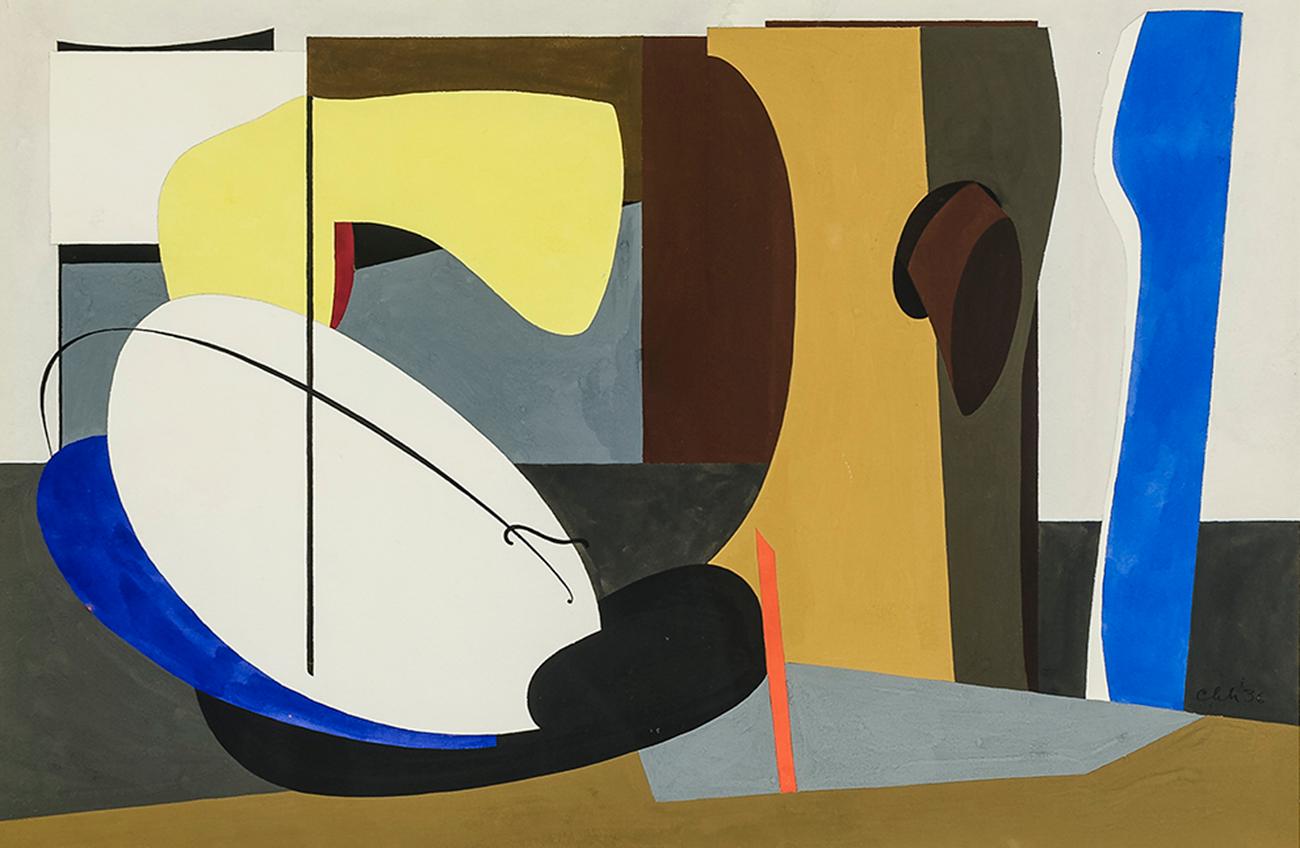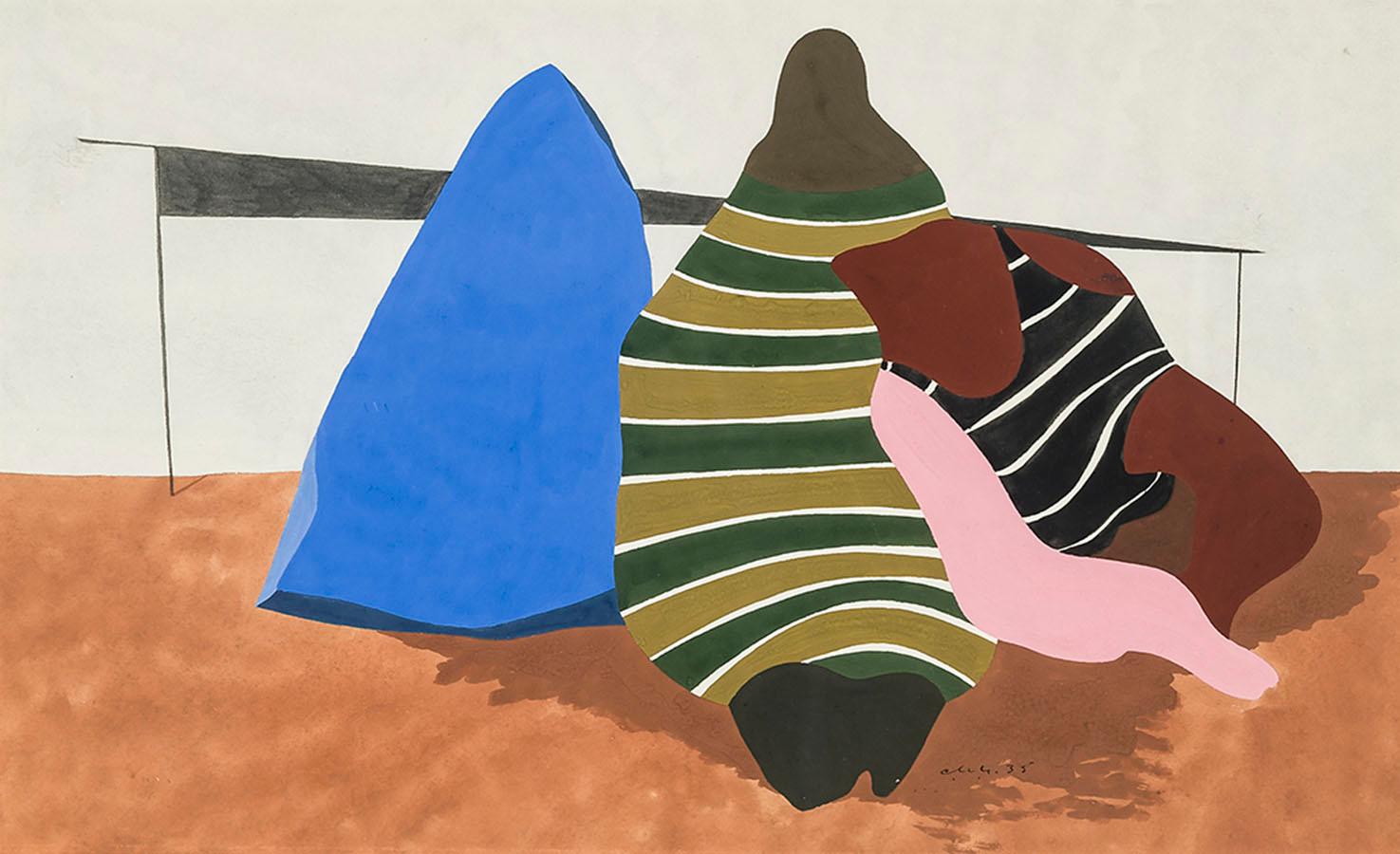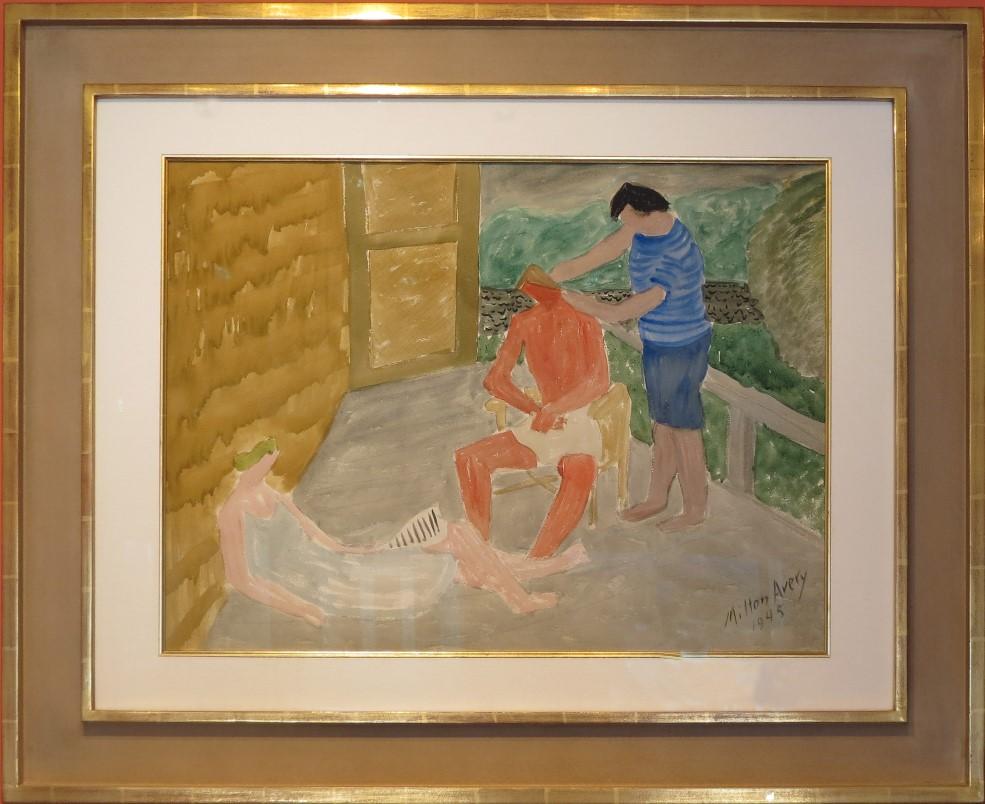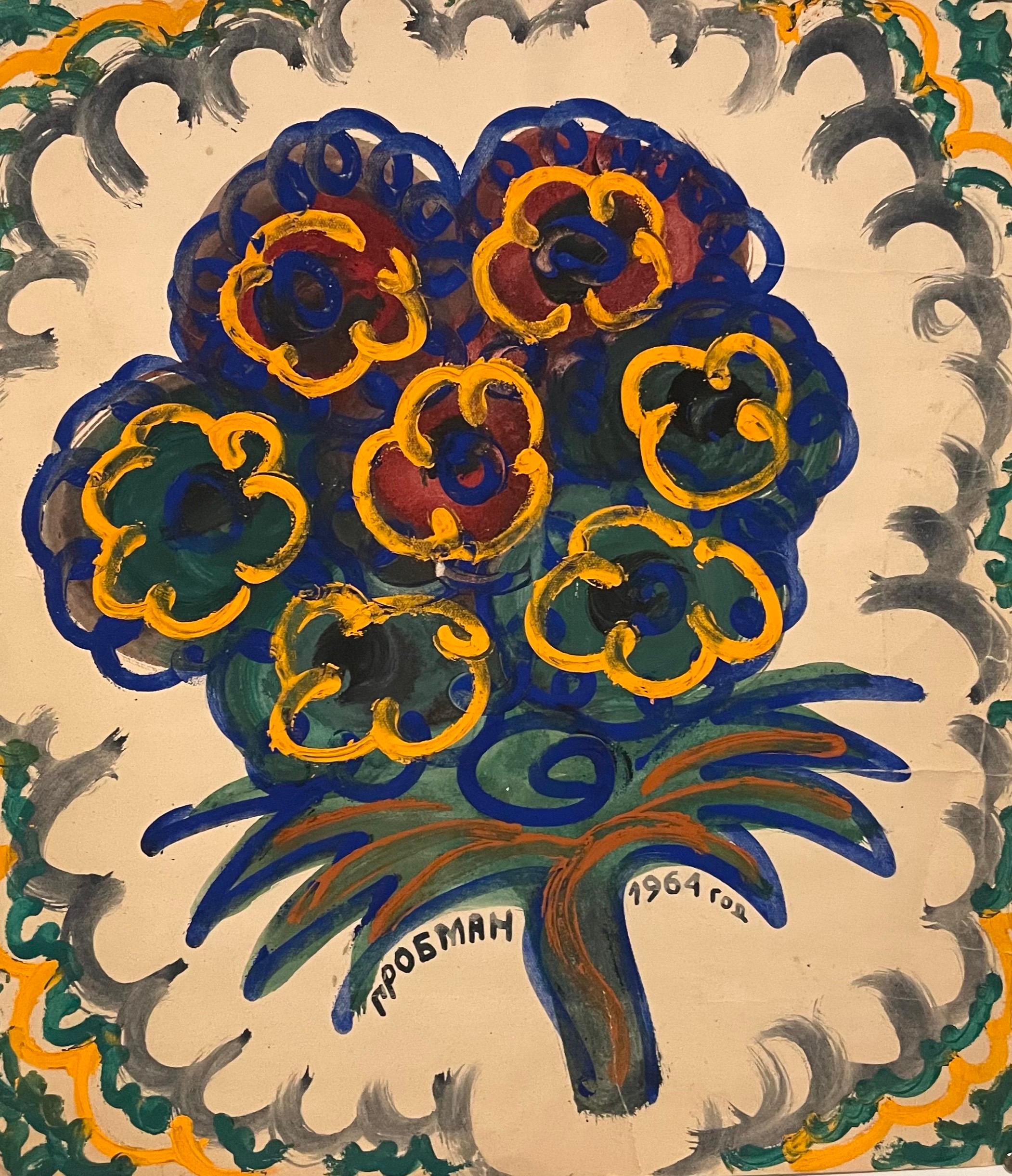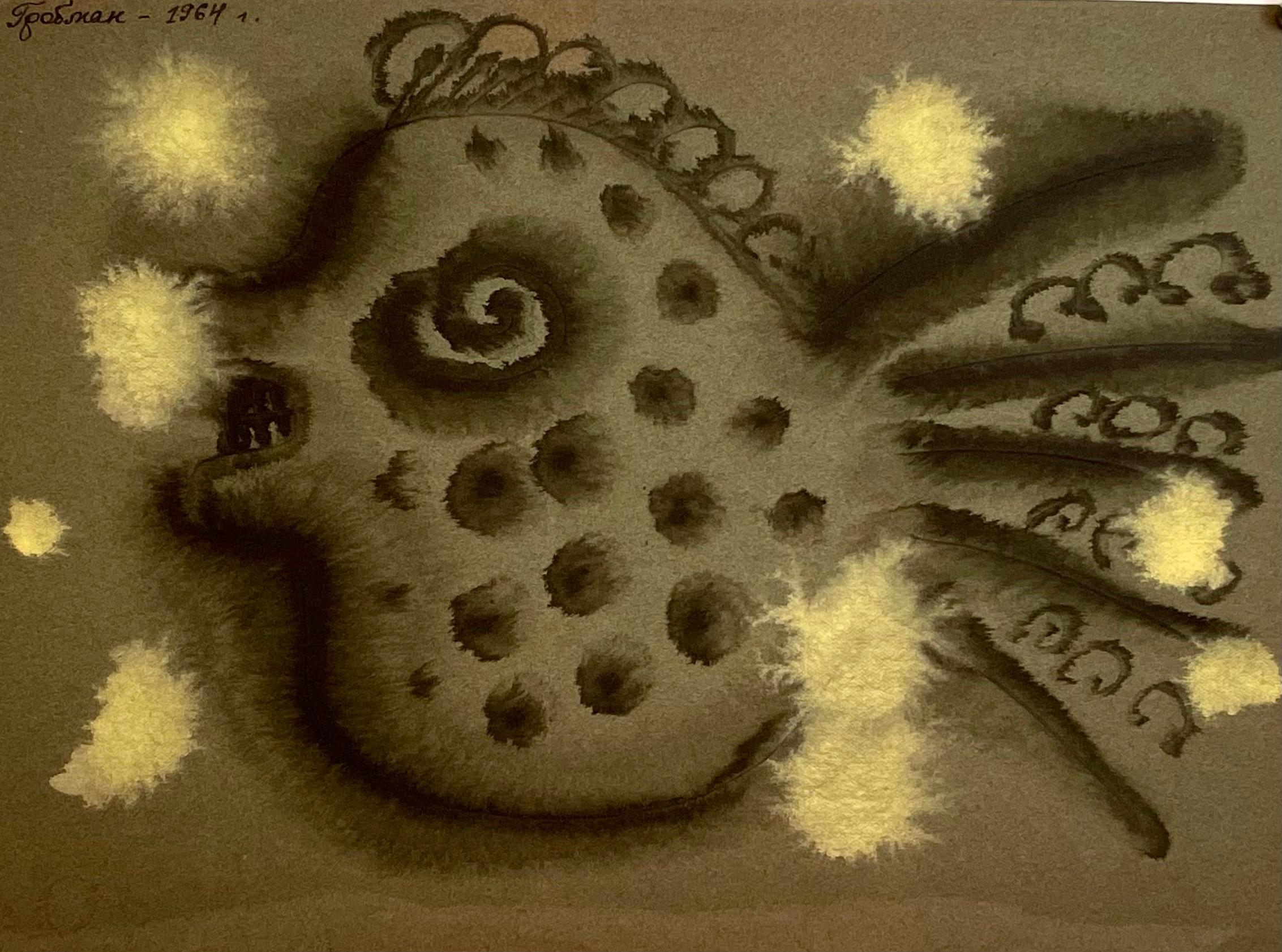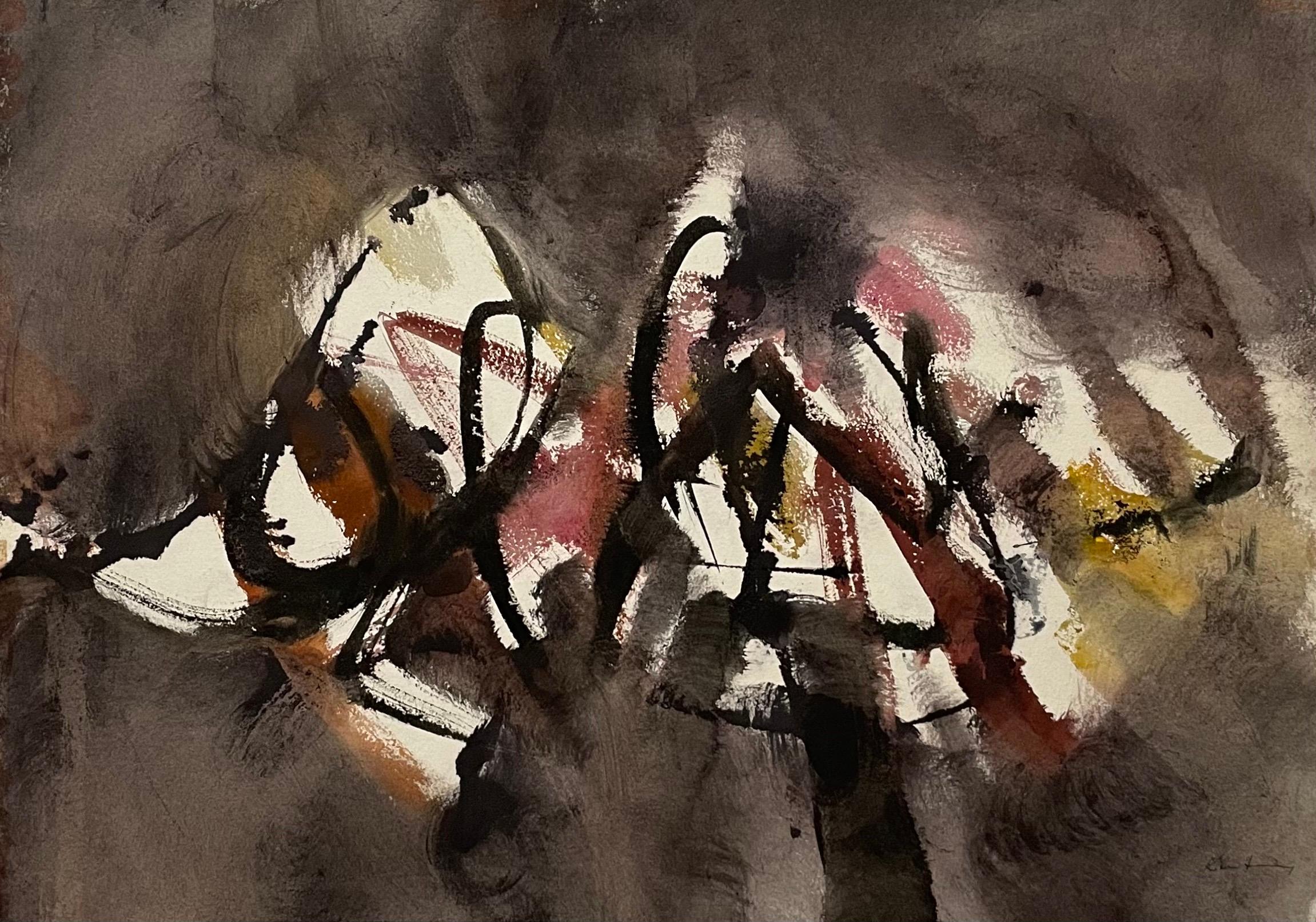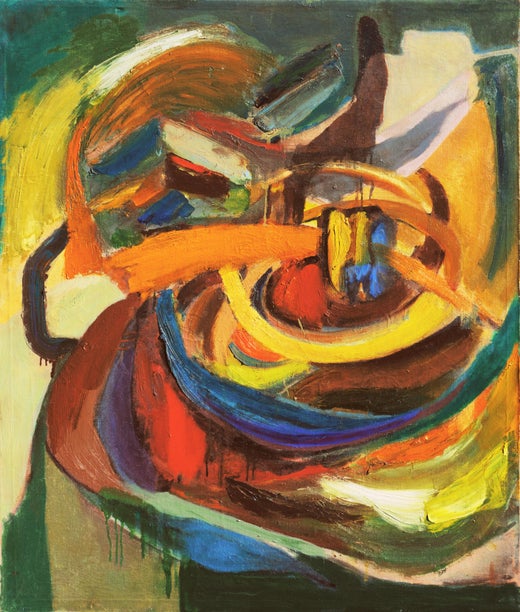Items Similar to 'Village in Tuscany', California Modernist woman artist, SFAA
Want more images or videos?
Request additional images or videos from the seller
1 of 14
Dora Masters'Village in Tuscany', California Modernist woman artist, SFAACirca 1965
Circa 1965
About the Item
A semi-abstracted study of a Tuscan townscape with warm terra-cotta roofs and stucco hues of saffron and crimson.
Signed lower right, 'D. Masters' for Dora Masters (American, 1916-2003) and painted circa 1965.
This listed, California woman artist exhibited widely and with success throughout the 1950s and '60s, including at the San Francisco Art Association and the Carmel Art Association. We are pleased to offer this dynamic and painterly semi-abstract by a notable California modernist.
- Creator:Dora Masters (1916 - 2003, American)
- Creation Year:Circa 1965
- Dimensions:Height: 20 in (50.8 cm)Width: 18.5 in (46.99 cm)
- Medium:
- Movement & Style:
- Period:
- Condition:original artist pin holes, minor restoration, minor creasing and rippling; unframed; shows well.
- Gallery Location:Santa Cruz, CA
- Reference Number:1stDibs: LU3443162941
Dora Masters
Dora Masters was an American artist born in 1916. She exhibited widely and with success throughout the 1950s and 60s, including at the San Francisco Art Association. Masters passed away in 2003.
About the Seller
5.0
Platinum Seller
These expertly vetted sellers are 1stDibs' most experienced sellers and are rated highest by our customers.
Established in 1982
1stDibs seller since 2013
637 sales on 1stDibs
Typical response time: <1 hour
- ShippingRetrieving quote...Ships From: Santa Cruz, CA
- Return PolicyA return for this item may be initiated within 3 days of delivery.
More From This SellerView All
- 'Evening Landscape' Bay Area Abstraction, San Francisco Museum of Fine Arts, CWSBy Robert George GilbergLocated in Santa Cruz, CASigned lower right, 'Gilberg' for Robert George Gilberg (American, 1911-1970) and painted circa 1965. Born in Oakland, Robert George Gilberg first studied at the Oakland Art Center during the 1930s. Following service during WWII, he settled in Nevada City, California where he lived and painted until shortly before his death in San Francisco. Gilberg exhibited widely and with success and was the recipient of numerous medals, prizes and juried awards, including at the San Francisco Museum of Fine Arts...Category
1960s American Modern Landscape Drawings and Watercolors
MaterialsPaper, Ink, Watercolor
- 'Abstracted Figure', Sydney, Museum of Modern Art in Sao Paulo, BrazilLocated in Santa Cruz, CASigned lower right, 'Bonorat' and painted circa 1980 An elegant, modernist figural painting and early work by this Sydney-based Mexican artist who studied at the National School of Fine Arts in Mexico City (1982-84) and, subsequently, at the Museum of Modern Art in Sao Paulo, Brazil (1986). STUDIES 1982-1984 Painting and Drawing Ateliers – National School of Fine Arts, Mexico City 1985-1986 Artistic Experimentation – Carrillo Hill Museum, Mexico City 1986 Metal Engraving – Museum of Modern Art Sao Paulo Brazil SOLO EXHIBITIONS 1986 Art Gallery of Santos Municipal Cultural Centre, Sao Paulo, Brazil 1988 Art Gallery of Porto Alegre Municipal centre, R.S. Brazil 1991 Gallery Casa de la Cultura, Morelia Mexico 1994 The Beatty Gallery, Sydney 1996 The Beatty Gallery, Sydney 1996 Michael Burke Gallery, Brisbane 1997 The Beatty Gallery, Sydney 2019 ‘Golden Trinity’, Thienny Lee Gallery, Sydney 2019 ‘Continuous Thread, GAFFA Gallery, Sydney GROUP EXHIBITIONS 1985 Mail Art Network Kyoto City Museum, Kyoto Japan 1987 Banespa Cultural Centre, Sao Paulo Brazil 1988 IV National Contest of Fine Arts, Cubatao Brazil 1992 NCA Gallery, Sydney 1994 The Beatty Gallery, Sydney 1994/5/6 Selected for the “Fisher’s Ghost” Art...Category
1980s Modern Figurative Drawings and Watercolors
MaterialsPaper, Ink, Watercolor, Gouache
- 'Abstract in Azure and Jade', Large American School WatercolorBy D.M. HubbardLocated in Santa Cruz, CAA substantial abstract watercolor comprising harmonious geometric forms arranged on a grid of blue, green, ivory and buff mosaic-like rectangles. Signed lower right "D.M. Hubbard" (A...Category
1970s Abstract Abstract Drawings and Watercolors
MaterialsWatercolor, Handmade Paper
- Winter ComingLocated in Santa Cruz, CASigned lower left, 'Donna Dearden'; additionally signed on old backing, titled, 'Winter Coming' and painted circa 1975. A semi-abstracted study of abscised leaves against a variegat...Category
1970s Abstract Abstract Drawings and Watercolors
MaterialsPaper, Watercolor, Gouache
- 'Musical Abstract', Smithsonian, Jewish Museum, Woman Artist, Phoenix, New YorkBy Beth Ames SwartzLocated in Santa Cruz, CASigned lower right, 'Beth Ames Swartz' (American, born 1936) and dated 1966. Primarily working in the idioms of abstraction and semi-abstraction, Beth Ames Swarts's paintings and mixed-media works are commonly informed by philosophical and spiritual concepts shared by people of different cultural world-views, and incorporate both symbols and words in the vocabulary of their visual language. Beth's art practice has been guided by aesthetic philosophies including Wassily Kandinsky’s Concerning the Spiritual in Art and Robert Smithson’s Spiral Jetty, and inspired by various religious and philosophical systems including Native American Healing practices, Buddhism, Jewish Mysticism, and Christianity in order to facilitate communication with viewers on both a conscious and unconscious level. Swartz syncretizes a variety of spiritual traditions in her work in order to reveal their inherent commonality. Born in New York City, Beth grew up in Manhattan, and by her mid-teens, was studying at the Art Students League in New York in the late 1940s. Her education continued at NYC's High School of Music & Art followed by Cornell University where she graduated with a Bachelor of Science (1957), followed by a Master of Arts degree (1959) from New York University. Beth Ames Swartz exhibited nationwide including at over seventy solo exhibitions including a solo show at The Jewish Museum in New York. In addition, she participated in three major traveling museum exhibitions and her work is held in the permanent collections of numerous major museums including the National Museum of American Art at the Smithsonian. She received the Governor's Individual Artist Award in 2001 in Arizona, and a retrospective of her work was mounted in 2002 at The Phoenix Art Museum, with a monograph about her work co-published by The Phoenix Art Museum and Hudson Hills Press. Fellowships, Awards, Grants and Honors: New York, NY - 2003 Veteran Feminists of America, Medal of Honor Phoenix, AZ - 2001 Recipient, Governor's Arts Award, the highest honor in Arizona for one individual who may be a visual or performing artist or a writer. Snowmass Village, CO - 2000 Anderson Ranch, Artist in Residence Phoenix, AZ - 1994 Founder, Culture Care , an international, non-profit organization sponsoring The Sacred Souls Project, to identify, support and honor individuals who demonstrate positive human societal values New York, NY - 1994 Awarded Flow Fund grant for discretionary philanthropic use for non-personal benefit New York, NY - 1994 Panelist, College Art Association, Art, Earth and Medicine: A Healing Approach New York, NY - 1993 Panelist, The Sacred in the Arts Conference New York, NY - 1992 Speaker, MedArts Conference, Research Study on A Moving Point of Balance Stinson Beach, CA - 1991 Speaker, Symposium, Art as a Healing Force New Harmony, IN - 1990 Keynote Speaker, Art and Healing Conference Phoenix, AZ - 1988 Co-Founder, International Friends of Transformative Art (IFTA), an international, non-profit organization for positive global change Payson, AZ - 1988, '87 Project Coordinator, Rim Institute, Transformative Artist's Conference and Workshop Phoenix, AZ - 1985 Governor's Award, Outstanding Women of Arizona - Women Who Create Sun Valley, ID - 1980 Sun Valley Center for the Arts & Humanities, Artist in Residence, The Awesome Space: The Inner and Outer Landscape Hawaii National Park, HI - 1979 Volcano Art Center, Artist in Residence Phoenix, AZ - 1978, '77 Named Master Teacher by State Department of Public Instruction Phoenix, AZ - 1978, '77 Educational Grant for Inquiry Into Fire, Arizona Commission on Arts and Humanities Selected Bibliography and Reference: Davenport’s Art Reference Guide, 2007/8 Edition, p.2468; Arizona/Women '75 (exhibition catalogue). Tucson, AZ: Tucson Art Museum, 1975; Baigell, Matthew. "Art and Spirit: Kabbalah and Jewish-American Artists." Tikkun vol. 14, no.4, (July-August 1999): 59-61 (illus. in b&w of Shen Qi Series: the Cabalistic Scheme of the Four Worlds #5); Beth Ames Swartz, Inquiry Into Fire (exhibition catalog). Scottsdale, AZ: Scottsdale Center for the Arts, 1978. Introduction by Melinda Wortz; Beth Ames Swartz, 1982-1988: A Moving Point of Balance (exhibition catalog). Scottsdale, AZ: A Moving Point of Balance, Inc., 1988. Introduction by John Perreault; Biennial 1979 (exhibition catalog). Phoenix: Phoenix Art Museum, March 9-April 8, 1979, 35-37, 64 (illus. in color Sedona, #23; illus. in b&w, Torah Scroll, #5); Body and Soul: Contemporary Art and Healing (exhibition catalog). Lincoln, MA: DeCordova Museum and Sculpture Park, 1994. Introduction by Rachel Rosenfeld Lafo, Nicholas Capasso, and Sara Rehm Roberts; Cembalest, Robin. "The Ecological Art Explosion." ARTnews vol. 90, no. 6 (summer 1991): 96-105; The First Western States Biennial Exhibition (exhibition catalog). Denver: Western States Art Foundation, 1979. Introduction by Joshua C. Taylor (with illus. in color of Torah Scroll #4); Gablik, Suzi. The Reenchantment of Art. Thames and Hudson: New York, 1991, 155-57; Gadon, Elinor W. The Once and Future Goddess: A Symbol for Our Time. New York: Harper and Row, 1989, 245-46; 248; Henderson, Barbara. "Beth Ames Swartz," A Magazine of Fine Arts vol. 2, no. 15 (April 1976): 34-41; Israel Revisited: Beth Ames Swartz (exhibition catalog). Scottsdale, AZ: Beth Ames Swartz, 1981: 40 pp. Introduction by Harry Rand...Category
1960s Abstract Abstract Drawings and Watercolors
MaterialsPaper, Watercolor
- 'Musical Bridge', New York Jewish Museum, ASL, Woman Artist, SmithsonianBy Beth Ames SwartzLocated in Santa Cruz, CASigned lower right, 'Beth Ames Swartz' (American, born 1936) and dated 1966. Primarily working in the idioms of abstraction and semi-abstraction, Beth's paintings and mixed-media works are commonly informed by philosophical and spiritual concepts shared by people of different cultural worldviews, and incorporate both symbols and words in the vocabulary of their visual language. Her art practice has been guided by aesthetic philosophies including Wassily Kandinsky’s Concerning the Spiritual in Art and Robert Smithson’s Spiral Jetty, and inspired by various religious and philosophical systems including Native American Healing practices, Buddhism, Jewish Mysticism, and Christianity in order to facilitate communication with viewers on both the conscious and unconscious level. Swartz synthesizes these spiritual traditions in her work with the purpose of revealing the commonality between them. Beth was born in New York City and grew up in Manhattan, and by her mid-teens was studying at the Art Students League in New York in the late 1940s. Her education continued at The High School of Music & Art in New York City, and Cornell University in Ithaca, New York, where she graduated in 1957 with a Bachelor of Science degree, followed by a Master of Arts degree in 1959 from New York University. Beth Ames Swartz exhibited nationwide including at over seventy solo exhibitions including a solo show at The Jewish Museum in New York. In addition, she participated in three major traveling museum exhibitions and her work is held in the permanent collections of numerous major museums including the National Museum of American Art at the Smithsonian. She received the Governor's Individual Artist Award in 2001 in Arizona, and a retrospective of her work was mounted in 2002 at The Phoenix Art Museum, with a monograph about her work co-published by The Phoenix Art Museum and Hudson Hills Press. Swartz explores systems of knowledge by translating philosophical concepts into aesthetic visual experiences. Fellowships, Awards, Grants and Honors: New York, NY - 2003 Veteran Feminists of America, Medal of Honor Phoenix, AZ - 2001 Recipient, Governor's Arts Award, the highest honor in Arizona for one individual who may be a visual or performing artist or a writer. Snowmass Village, CO - 2000 Anderson Ranch, Artist in Residence Phoenix, AZ - 1994 Founder, Culture Care , an international, non-profit organization sponsoring The Sacred Souls Project, to identify, support and honor individuals who demonstrate positive human societal values New York, NY - 1994 Awarded Flow Fund grant for discretionary philanthropic use for non-personal benefit New York, NY - 1994 Panelist, College Art Association, Art, Earth and Medicine: A Healing Approach New York, NY - 1993 Panelist, The Sacred in the Arts Conference New York, NY - 1992 Speaker, MedArts Conference, Research Study on A Moving Point of Balance Stinson Beach, CA - 1991 Speaker, Symposium, Art as a Healing Force New Harmony, IN - 1990 Keynote Speaker, Art and Healing Conference Phoenix, AZ - 1988 Co-Founder, International Friends of Transformative Art (IFTA), an international, non-profit organization for positive global change Payson, AZ - 1988, '87 Project Coordinator, Rim Institute, Transformative Artist's Conference and Workshop Phoenix, AZ - 1985 Governor's Award, Outstanding Women of Arizona - Women Who Create Sun Valley, ID - 1980 Sun Valley Center for the Arts & Humanities, Artist in Residence, The Awesome Space: The Inner and Outer Landscape Hawaii National Park, HI - 1979 Volcano Art Center, Artist in Residence Phoenix, AZ - 1978, '77 Named Master Teacher by State Department of Public Instruction Phoenix, AZ - 1978, '77 Educational Grant for Inquiry Into Fire, Arizona Commission on Arts and Humanities Selected Bibliography and Reference: Davenport’s Art Reference Guide, 2007/8 Edition, p.2468; Arizona/Women '75 (exhibition catalogue). Tucson, AZ: Tucson Art Museum, 1975; Baigell, Matthew. "Art and Spirit: Kabbalah and Jewish-American Artists." Tikkun vol. 14, no.4, (July-August 1999): 59-61 (illus. in b&w of Shen Qi Series: the Cabalistic Scheme of the Four Worlds #5); Beth Ames Swartz, Inquiry Into Fire (exhibition catalog). Scottsdale, AZ: Scottsdale Center for the Arts, 1978. Introduction by Melinda Wortz; Beth Ames Swartz, 1982-1988: A Moving Point of Balance (exhibition catalog). Scottsdale, AZ: A Moving Point of Balance, Inc., 1988. Introduction by John Perreault; Biennial 1979 (exhibition catalog). Phoenix: Phoenix Art Museum, March 9-April 8, 1979, 35-37, 64 (illus. in color Sedona, #23; illus. in b&w, Torah Scroll, #5); Body and Soul: Contemporary Art and Healing (exhibition catalog). Lincoln, MA: DeCordova Museum and Sculpture Park, 1994. Introduction by Rachel Rosenfeld Lafo, Nicholas Capasso, and Sara Rehm Roberts; Cembalest, Robin. "The Ecological Art Explosion." ARTnews vol. 90, no. 6 (summer 1991): 96-105; The First Western States Biennial Exhibition (exhibition catalog). Denver: Western States Art Foundation, 1979. Introduction by Joshua C. Taylor (with illus. in color of Torah Scroll #4); Gablik, Suzi. The Reenchantment of Art. Thames and Hudson: New York, 1991, 155-57; Gadon, Elinor W. The Once and Future Goddess: A Symbol for Our Time. New York: Harper and Row, 1989, 245-46; 248; Henderson, Barbara. "Beth Ames Swartz," A Magazine of Fine Arts vol. 2, no. 15 (April 1976): 34-41; Israel Revisited: Beth Ames Swartz (exhibition catalog). Scottsdale, AZ: Beth Ames Swartz, 1981: 40 pp. Introduction by Harry Rand...Category
1960s Abstract Abstract Drawings and Watercolors
MaterialsPaper, Watercolor
You May Also Like
- UntitledBy Charles Houghton HowardLocated in New York, NYCharles Houghton Howard was born in Montclair, New Jersey, the third of five children in a cultured and educated family with roots going back to the Massachusetts Bay colony. His fat...Category
20th Century American Modern Abstract Drawings and Watercolors
MaterialsPaper, Gouache, Graphite
- UntitledBy Charles Houghton HowardLocated in New York, NYCharles Houghton Howard was born in Montclair, New Jersey, the third of five children in a cultured and educated family with roots going back to the Massachusetts Bay colony. His fat...Category
20th Century American Modern Abstract Drawings and Watercolors
MaterialsPaper, Watercolor, Gouache, Graphite
- "Country Haircut"By Milton AveryLocated in Lambertville, NJJim’s of Lambertville Fine Art Gallery is proud to offer this piece by Milton Avery (1885 – 1965). Milton Avery was a prominent Modernist painter whose work combined abstraction and...Category
1940s American Modern Figurative Drawings and Watercolors
MaterialsWatercolor, Gouache, Paper
- Post Soviet Nonconformist Avant Garde Russian Israeli Gouache Painting GrobmanBy Michail GrobmanLocated in Surfside, FLMIchail Grobman Gouache and watercolor on paper Hand signed Lower Left and Dated 1964. Described inn Cyrillic Russian verso. Dimensions: L:13.25" W: 11.75". Michail Grobman (Russian: Михаил Гробман, Hebrew: מיכאיל גרובמן, born 1939) is an artist and a poet working in Israel and Russia. He is father to Hollywood producer Lati Grobman and Israeli architect Yasha Jacob Grobman. Biography 1939 – Born in Moscow. 1960s – Active member of The Second Russian Avant-Garde movement in the Soviet Union. 1967 – Member of Moscow Artists Union. 1971 – Emigrates to Israel and settles in Jerusalem. 1975 – Founded the Leviathan group and art periodical (in Russian). Since 1983, he lives and works mainly in Tel Aviv. Awards In 2001, Grobman was a co-recipient of the Dizengoff Prize for Painting. Solo exhibitions 2007 – Last Skies, Loushy & Peter Art & Projects, Tel Aviv (cat. text: Marc Scheps) 2006 – Creation From Chaos to Cosmos, Bar-David Museum of Fine Art and Judaica, Kibbutz Baram (cat. text: Sorin Heller) 2002 – The Last Sky, installation, Tsveta Zuzoritch pavilion, Belgrad (cat. text: Irina Subotitch) 1999 – Mikhail Grobman: Works 1960–1998, The State Russian Museum, St. Petersburg (cat. texts: Evgeniya Petrova, Marc Scheps, Lola Kantor-Kazovsky, Michail German) Michail Grobman was born in Moscow. He grew up writing poetry, essays and literary prose. In the 1960s, he was active in the Second Russian Avant-garde movement in the Soviet Union. In 1971, he immigrated to Israel. In 1975, he established the Leviathan school together with Avraham Ofek and Shmuel Ackerman, seeking to combine symbolism, metaphysics and Judaism in an all-inclusive “national style.” Grobman’s lithograph work employs images and symbols from Jewish mysticism and Kabbalah. His paintings incorporate texts in Russian and Hebrew. In addition to his artistic endeavors, he writes about art and aesthetics. The group combined conceptual art and "land art" with Jewish symbolism. Of the three of them Avraham Ofek had the deepest interest in sculpture and its relationship to religious symbolism and images. In one series of his works Ofek used mirrors to project Hebrew letters, words with religious or cabbalistic significance, and other images onto soil or man-made structures. In his work "Letters of Light" (1979), for example, the letters were projected onto people and fabrics and the soil of the Judean Desert. In another work Ofek screened the words "America", "Africa", and "Green card" on the walls of the Tel Hai courtyard during a symposium on sculpture Part of the generation of emigre Russian artists, many Jewish, that included Yuri Kuper, Komar and Melamid, Eduard Steinberg, Erik Bulatov, Viktor Pivovarov, Vladimir Yankilevsky, Ilya Kabakov and Grisha Bruskin. Date of Birth: 1939, Moscow 1960s Active member of The Second Russian Avant Garde 1967 Member of the Moscow Painters Association 1971 Immigrated to Israel and settled in Jerusalem 1975 Founded the Leviathan group and art periodical (in Russian) Since 1983 Lives and works in Tel Aviv . Selected Solo Exhibitions: 2002 Pavilion Zveta Zuzovich, "The Last Sky", Belgrad (cat: Irena Subotitch) 1999 The State Russian Museum, ST. Petersburg 1998 "Picture = Symbol + Concept", Herzliya Museum of Art, Herzliya 1995 "Password and Image", University Gallery, Haifa University 1990 Tova Osman Gallery, Tel Aviv 1989 "The Beautiful Sixties in Moscow", The Genia Schreiber University Art Gallery, Tel Aviv University (with llya Kabakov; cat. text: Mordechai Omer] Spertus Museum, Chicago Beit Rami and Uri Nechushtan, Ashdot Yaacov (leaflet) 1972 Nora Gallery, Jerusalem 1973 - Negev Museum, Beer Sheva 1971 Tel Aviv Museum of Art (cat. text: Haim Gamzu) 1966 Mos-lng-Projekt, Moscow 1965 Artist's House, Moscow Energy Institute, Moscow History Institute, Moscow Usti-nad-Orlicy Theatre,Czechoslovakia (leaflet text: Dushan Konetchni) 1959 Mukhina Art Institute, Leningrad . Selected Group Exhibitions: 2003 "Yes do yourself...", Regeneration of Judaism in Israeli art, Zman Omanut Tel Aviv (cat: Gideon Ofrat) 1999 "Russian post-war avantgarde", The Trajsman Collection in the State Russian Museum, St. Petersburg Tretjakov National Gallery, Moscow (cat. text: Yevgenij Barabanov, John Bolt...Category
1960s Modern Abstract Paintings
MaterialsPaper, Watercolor, Gouache
- Post Soviet Nonconformist Avant Garde Russian Israeli Gouache Painting GrobmanBy Michail GrobmanLocated in Surfside, FLMichail Gorbman, Russian Born 1939. Watercolor on Green Paper, Black Fish with Yellow Dots. Hand signed Upper Left, Dated 1964. Signed verso and Described. Dimensions: 10 X 7.25 inches \ Michail Grobman (Russian: Михаил Гробман, Hebrew: מיכאיל גרובמן, born 1939) is an artist and a poet working in Israel and Russia. He is father to Hollywood producer Lati Grobman and Israeli architect Yasha Jacob Grobman. Biography 1939 – Born in Moscow. 1960s – Active member of The Second Russian Avant-Garde movement in the Soviet Union. 1967 – Member of Moscow Artists Union. 1971 – Emigrates to Israel and settles in Jerusalem. 1975 – Founded the Leviathan group and art periodical (in Russian). Since 1983, he lives and works mainly in Tel Aviv. Awards In 2001, Grobman was a co-recipient of the Dizengoff Prize for Painting. Solo exhibitions 2007 – Last Skies, Loushy & Peter Art & Projects, Tel Aviv (cat. text: Marc Scheps) 2006 – Creation From Chaos to Cosmos, Bar-David Museum of Fine Art and Judaica, Kibbutz Baram (cat. text: Sorin Heller) 2002 – The Last Sky, installation, Tsveta Zuzoritch pavilion, Belgrad (cat. text: Irina Subotitch) 1999 – Mikhail Grobman: Works 1960–1998, The State Russian Museum, St. Petersburg (cat. texts: Evgenija Petrova, Marc Scheps, Lola Kantor-Kazovsky, Michail German) Michail Grobman was born in Moscow. He grew up writing poetry, essays and literary prose. In the 1960s, he was active in the Second Russian Avant-garde movement in the Soviet Union. In 1971, he immigrated to Israel. In 1975, he established the Leviathan school together with Avraham Ofek and Shmuel Ackerman, seeking to combine symbolism, metaphysics and Judaism in an all-inclusive “national style.” Grobman’s lithograph work employs images and symbols from Jewish mysticism and Kabbalah. His paintings incorporate texts in Russian and Hebrew. In addition to his artistic endeavors, he writes about art and aesthetics. The group combined conceptual art and "land art" with Jewish symbolism. Of the three of them Avraham Ofek had the deepest interest in sculpture and its relationship to religious symbolism and images. In one series of his works Ofek used mirrors to project Hebrew letters, words with religious or cabbalistic significance, and other images onto soil or man-made structures. In his work "Letters of Light" (1979), for example, the letters were projected onto people and fabrics and the soil of the Judean Desert. In another work Ofek screened the words "America", "Africa", and "Green card" on the walls of the Tel Hai courtyard during a symposium on sculpture Part of the generation of emigre Russian artists, many Jewish, that included Yuri Kuper, Komar and Melamid, Eduard Steinberg, Erik Bulatov, Viktor Pivovarov, Vladimir Yankilevsky, Ilya Kabakov and Grisha Bruskin. Date of Birth: 1939, Moscow 1960s Active member of The Second Russian Avant Garde 1967 Member of the Moscow Painters Association 1971 Immigrated to Israel and settled in Jerusalem 1975 Founded the Leviathan group and art periodical (in Russian) Since 1983 Lives and works in Tel Aviv . Selected Solo Exhibitions: 2002 Pavilion Zveta Zuzovich, "The Last Sky", Belgrad (cat: Irena Subotitch) 1999 The State Russian Museum, ST. Petersburg 1998 "Picture = Symbol + Concept", Herzliya Museum of Art, Herzliya 1995 "Password and Image", University Gallery, Haifa University 1990 Tova Osman Gallery, Tel Aviv 1989 "The Beautiful Sixties in Moscow", The Genia Schreiber University Art Gallery, Tel Aviv University (with llya Kabakov; cat. text: Mordechai Omer] Spertus Museum, Chicago Beit Rami and Uri Nechushtan, Ashdot Yaacov (leaflet) 1972 Nora Gallery, Jerusalem 1973 - Negev Museum, Beer Sheva 1971 Tel Aviv Museum of Art (cat. text: Haim Gamzu) 1966 Mos-lng-Projekt, Moscow 1965 Artist's House, Moscow Energy Institute, Moscow History Institute, Moscow Usti-nad-Orlicy Theatre,Czechoslovakia (leaflet text: Dushan Konetchni) 1959 Mukhina Art Institute, Leningrad . Selected Group Exhibitions: 2003 "Yes do yourself...", Regeneration of Judaism in Israeli art, Zman Omanut Tel Aviv (cat: Gideon Ofrat) 1999 "Russian post-war avantgarde", The Trajsman Collection in the State Russian Museum, St. Petersburg Tretjakov National Gallery, Moscow (cat. text: Yevgenij Barabanov, John...Category
20th Century Modern Animal Drawings and Watercolors
MaterialsPaper, Watercolor
- Modernist Abstract Expressionist Watercolor Painting Bauhaus Weimar ArtistBy Pawel KontnyLocated in Surfside, FLAbstract watercolor composition bearing the influence of the earlier color-block compositions of Paul Klee. Pawel August Kontny, (Polish-German-American artist) He was born in Laurahuette, Poland, in 1923, the son of a wealthy pastry shop owner. In 1939 he began studying architecture in Breslau where he was introduced to the European masters and to the work of some of the German Expressionists, soon afterward banned as "degenerate artists" and removed from museums throughout Germany by the Nazi regime. His studies were interrupted by World War II. Drafted into the German army, traveling in many countries as a soldier, he sketched various landscapes but in 1945, he was captured and held as a prisoner of war in Italy. After the war, he studied at the Union of Nuremberg Architects to help design buildings to replace ones destroyed in the war. He recorded his impressions of the local population and the landscapes through his watercolors and drawings. Pawel Kontny thereafter moved to Nuremberg, Germany, becoming a member of the Union of Nuremberg Architects and helping to rebuild the city's historic center. He soon decided to concentrate on his professional art career. He married Irmgard Laurer, a dancer with the Nuremberg Opera. Pavel Kontny 's career as an artist was launched with his participation in an all German exhibition, held at the Dusseldorf Museum in 1952. He held one-man shows in Germany, Switzerland and the United States. During his trip to the United States in 1960, Kontny became instantly enamored with Colorado, and decided to relocate to Cherry Hills with his wife and two children. He quickly established himself in the local art community, being affiliated for a time with Denver Art Galleries and Saks Galleries. His subject matter became the Southwest. During this time he received the Prestigious Gold Medal of the Art Academy of Rome. His extensive travel provided material for the paintings he did using his hallmark marble dust technique. he also worked equally in pastel, watercolor, charcoal and pencil-and-ink. in a style which merged abstraction and realist styles, influenced by Abstract Expressionist painting and South Western American landscapes. In the early 1960s he was one of only a few European-born professional artists in the state, a select group that included Herbert Bayer (1900-1985), a member of the prewar Bauhaus in Weimar and Dessau, Germany, and Roland Detre (1903-2001), a Hungarian modernist painter. As a Denver, Colorado resident, Pavel Kontny exhibited at galleries and museums throughout the United States, Germany and Japan. There, he was inspired by frequent trips to Native American pueblos in the Southwest, as well as by the study of the Plains Indians of Montana and Wyoming. Over the years Kontny had a number of students and generously helped young artist by hosting exhibitions at his Cherry Hills home. For many years he generously donated his paintings to support charitable causes in Denver. Influences during his European years included German pastelist C.O. Muller, German Informel painter Karl Dahmen and Swiss artist, Hans Erni. In the early 1950s his painting style showed the influence of the Die Brücke (The Bridge), a group of German expressionist artists formed in Dresden in 1905 who had a major impact on the evolution of modern art in the twentieth century in Germany. By the middle of the decade his style incorporated more referential abstraction and total abstraction, resulting in part from his study of Hans Hartung, a German artist based in Paris who exhibited his gestural abstract work in Germany. His work also bears the influence of Sam Francis. The American moon landing in 1969 inspired Paul Kontny...Category
Mid-20th Century American Modern Abstract Drawings and Watercolors
MaterialsWatercolor, Archival Paper
Recently Viewed
View AllMore Ways To Browse
California Art And Artists
Woman Artists
Vintage Masters
Modern Masters Art
Artist At The Village
Masters Drawings Signed
Carmel Art
Midcentury Californian Artists
California Modernist
California Artist Mid Century Modern
San Francisco Modernist
California Mid Century Painters
California Modernist Abstract
Tuscany Painting
California Mid Century Watercolor
Painting Of Tuscany
Tuscan Artist
American Terra Cotta
